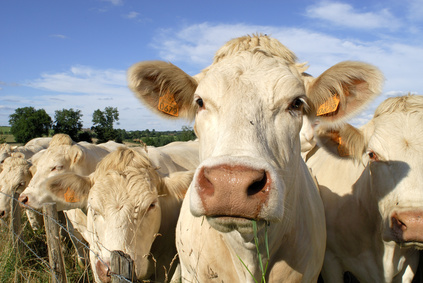
Earlier this year, the U.S. Department of Agriculture lifted the 1996 ban on European beef following the mad-cow outbreak. Following the lift, Ireland is trying to brand its beef as the next trendy meat. So, why don’t we French promote Charolais beef in the United States?
Earlier this year, the Department of Agriculture lifted the ban placed on European beef in 1996 because of the mad-cow outbreak. Following the lift, Ireland seeks to brand its beef as the next trendy meat with its grass-fed cows that live outdoors and get plenty of exercise, which leads to leaner meat. All together, according to BusinessWeek “it has a stronger, almost gamey flavor.”
Stop. Hold on a second. I love Ireland. It’s a beautiful country with amazing, nice people. But I associate Irish food with Guinness, whiskey, and potatoes, as do many Americans. I’d never associate Ireland with beef. Moreover, if Ireland is trying to push its beef on the American market, why don’t we French promote Charolais beef for the American market also? Americans associate French food with fine, exclusive, and expensive meals. Okay, sometimes it also connotes weird food like frog legs or snails. But it seems to me that French food would be a better match than Irish food, wouldn’t it?
Charolais beef vs. Irish beef
My point is not that Charolais beef is better than Irish beef. My point is that once more, we French fail to recognize our potential in the American market (of around 320 million people), and we often do not see the strength of the reputation of French food.
In the United States, French food is mostly made from generic products with low added value that are easy to copy. California wines are excellent and can compete with French Bordeaux, while local baguettes and other pastries have become largely generic in American supermarkets. But we still have amazing produce in France that we hardly export outside the European market. In fact, French SMEs seem almost afraid to export their goods.
Yes, it is challenging for a French SME to go overseas. Many French managers lack the proper English language skills. They are not alone. In January 2010 while standing in the rain, the former French president Nicolas. Sarkozy said to the then U.S. Secretary of State Hillary Clinton, “Sorry for the bad time.” Of course, Mr. Sarkozy mistakenly translated the French word “temps” by saying “time” instead of “weather“. He actually meant to say “Sorry for the bad weather.”
The current French president François Hollande fared no better with his English skills. When Mr. Hollande attempted to show off his English skills to President Obama, he closed a congratulatory letter following Obama’s reelection with the word “Friendly.” Mr. Hollande had intended to convey the idea of “amicalement,“ which translates more closely to “Kind regards.”
A long way to go with digital media
A recent survey shows that in the region of Grand Paris, only 85% of exporting companies have a website. That’s crazy, isn’t it? Nearly 15% of exporting companies in the Paris area don’t have a website! Of these exporting enterprises with a website, only 66% have a website available in English. Looking at these figures, I’m not surprised that only 35% of French SMEs export. In Germany, on the other hand, the share of exporting SMEs is approximately 98%.
Back to my beef. Winning the beef market won’t be easy. America is the largest consumer of beef in the world. According to BusinessWeek, its consumption per capita is double that of Europe. Great grass-fed beef is available from American cows, so unless a supplier has something special to offer like Japanese Wagyu beef, the effort of importing beef is often pointless.
Is an innovative beef supply all about marketing? In part, yes, but building the brand of our excellent French Charolais beef is certainly worth it
If you are planning this type of market entry in the States, talk to professionals (like me!) with expertise in your home market and target market and beware of common mistakes made by international companies. Get an expert (me again!) review of your strategy here!
You might also be interested in reading these articles: 8 Tips for Doing Business with European Companies during the Summer or New Media: French SMEs like Catimini USA are lagging behind
Photo credit by © Pascal Martin



Having a look at Charolais, I found the American International Charolais Association. It seems that the name has made some way but rather as a local breed than an import product.
I was also wondering if a key obstacle for French meat producers could be the meat cut, which is different in France and the US. Would French meat producers be ready to offer T-Bones and Ribeye of Charolais instead of entrecôte or Chateaubriand?
A good question! Anybody here with a strong opinion about this? “Would French meat producers be ready to offer T-Bones and Ribeye of Charolais instead of entrecôte or Chateaubriand?”